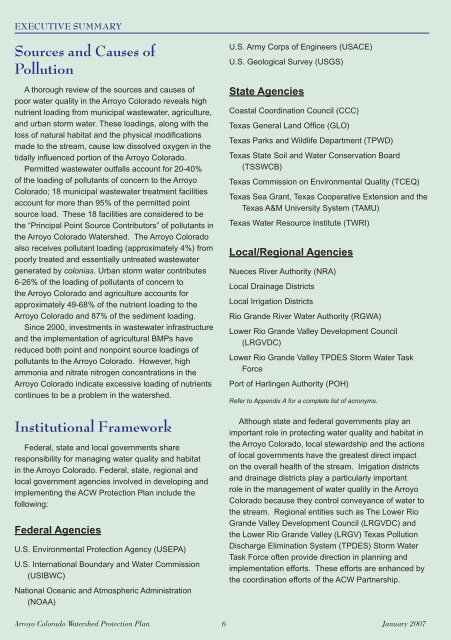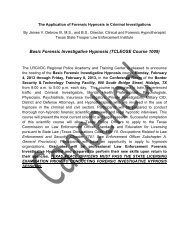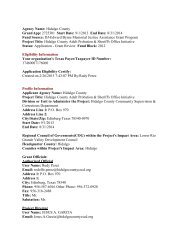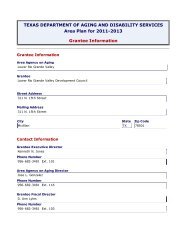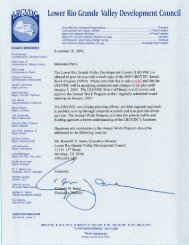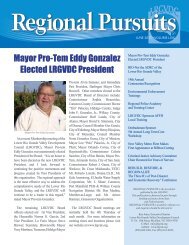Watershed Protection Plan - Lower Rio Grande Valley Development ...
Watershed Protection Plan - Lower Rio Grande Valley Development ...
Watershed Protection Plan - Lower Rio Grande Valley Development ...
Create successful ePaper yourself
Turn your PDF publications into a flip-book with our unique Google optimized e-Paper software.
EXECUTIVE SUMMARY<br />
Sources and Causes of<br />
Pollution<br />
A thorough review of the sources and causes of<br />
poor water quality in the Arroyo Colorado reveals high<br />
nutrient loading from municipal wastewater, agriculture,<br />
and urban storm water. These loadings, along with the<br />
loss of natural habitat and the physical modifi cations<br />
made to the stream, cause low dissolved oxygen in the<br />
tidally infl uenced portion of the Arroyo Colorado.<br />
Permitted wastewater outfalls account for 20-40%<br />
of the loading of pollutants of concern to the Arroyo<br />
Colorado; 18 municipal wastewater treatment facilities<br />
account for more than 95% of the permitted point<br />
source load. These 18 facilities are considered to be<br />
the “Principal Point Source Contributors” of pollutants in<br />
the Arroyo Colorado <strong>Watershed</strong>. The Arroyo Colorado<br />
also receives pollutant loading (approximately 4%) from<br />
poorly treated and essentially untreated wastewater<br />
generated by colonias. Urban storm water contributes<br />
6-26% of the loading of pollutants of concern to<br />
the Arroyo Colorado and agriculture accounts for<br />
approximately 49-68% of the nutrient loading to the<br />
Arroyo Colorado and 87% of the sediment loading.<br />
Since 2000, investments in wastewater infrastructure<br />
and the implementation of agricultural BMPs have<br />
reduced both point and nonpoint source loadings of<br />
pollutants to the Arroyo Colorado. However, high<br />
ammonia and nitrate nitrogen concentrations in the<br />
Arroyo Colorado indicate excessive loading of nutrients<br />
continues to be a problem in the watershed.<br />
Institutional Framework<br />
Federal, state and local governments share<br />
responsibility for managing water quality and habitat<br />
in the Arroyo Colorado. Federal, state, regional and<br />
local government agencies involved in developing and<br />
implementing the ACW <strong>Protection</strong> <strong>Plan</strong> include the<br />
following:<br />
Federal Agencies<br />
U.S. Environmental <strong>Protection</strong> Agency (USEPA)<br />
U.S. International Boundary and Water Commission<br />
(USIBWC)<br />
National Oceanic and Atmospheric Administration<br />
(NOAA)<br />
U.S. Army Corps of Engineers (USACE)<br />
U.S. Geological Survey (USGS)<br />
State Agencies<br />
Coastal Coordination Council (CCC)<br />
Texas General Land Offi ce (GLO)<br />
Texas Parks and Wildlife Department (TPWD)<br />
Texas State Soil and Water Conservation Board<br />
(TSSWCB)<br />
Texas Commission on Environmental Quality (TCEQ)<br />
Texas Sea Grant, Texas Cooperative Extension and the<br />
Texas A&M University System (TAMU)<br />
Texas Water Resource Institute (TWRI)<br />
Local/Regional Agencies<br />
Nueces River Authority (NRA)<br />
Local Drainage Districts<br />
Local Irrigation Districts<br />
<strong>Rio</strong> <strong>Grande</strong> River Water Authority (RGWA)<br />
<strong>Lower</strong> <strong>Rio</strong> <strong>Grande</strong> <strong>Valley</strong> <strong>Development</strong> Council<br />
(LRGVDC)<br />
<strong>Lower</strong> <strong>Rio</strong> <strong>Grande</strong> <strong>Valley</strong> TPDES Storm Water Task<br />
Force<br />
Port of Harlingen Authority (POH)<br />
Refer to Appendix A for a complete list of acronyms.<br />
Although state and federal governments play an<br />
important role in protecting water quality and habitat in<br />
the Arroyo Colorado, local stewardship and the actions<br />
of local governments have the greatest direct impact<br />
on the overall health of the stream. Irrigation districts<br />
and drainage districts play a particularly important<br />
role in the management of water quality in the Arroyo<br />
Colorado because they control conveyance of water to<br />
the stream. Regional entities such as The <strong>Lower</strong> <strong>Rio</strong><br />
<strong>Grande</strong> <strong>Valley</strong> <strong>Development</strong> Council (LRGVDC) and<br />
the <strong>Lower</strong> <strong>Rio</strong> <strong>Grande</strong> <strong>Valley</strong> (LRGV) Texas Pollution<br />
Discharge Elimination System (TPDES) Storm Water<br />
Task Force often provide direction in planning and<br />
implementation efforts. These efforts are enhanced by<br />
the coordination efforts of the ACW Partnership.<br />
Arroyo Colorado <strong>Watershed</strong> <strong>Protection</strong> <strong>Plan</strong> 6 January 2007


